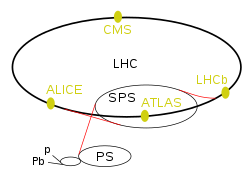 Plan of the LHC experiments and the preaccelerators. | |
| LHC experiments | |
|---|---|
| ATLAS | A Toroidal LHC Apparatus |
| CMS | Compact Muon Solenoid |
| LHCb | LHC-beauty |
| ALICE | A Large Ion Collider Experiment |
| TOTEM | Total Cross Section, Elastic Scattering and Diffraction Dissociation |
| LHCf | LHC-forward |
| MoEDAL | Monopole and Exotics Detector At the LHC |
| FASER | ForwArd Search ExpeRiment |
| SND | Scattering and Neutrino Detector |
| LHC preaccelerators | |
| p and Pb | Linear accelerators for protons (Linac 4) and lead (Linac 3) |
| (not marked) | Proton Synchrotron Booster |
| PS | Proton Synchrotron |
| SPS | Super Proton Synchrotron |
FASER (ForwArd Search ExpeRiment) is one of the nine particle physics experiments in 2022 at the Large Hadron Collider at CERN. It is designed to both search for new light and weakly coupled elementary particles, and to detect and study the interactions of high-energy collider neutrinos.[1] In 2023, FASER and SND@LHC reported the first observation of collider neutrinos.[2]
The experiment is installed in the service tunnel TI12, which is 480 m downstream from the interaction point used by the ATLAS experiment.[3] This tunnel was formerly used to inject the beam from the SPS into the LEP accelerator. In this location, the FASER experiment is placed into an intense and highly collimated beam of both neutrinos as well as possible new particles. Additionally, it is shielded from ATLAS by about 100 meters of rock and concrete, providing a low background environment. The FASER experiment was approved in 2019.[4][5] The detector was built in the following two years and installed in 2021.[6] The experiment started taking data at the beginning of Run 3 of the LHC in summer 2022.[7][8][9]
- ^ "FASER detector at the Large Hadron Collider to seek clues about hidden matter in the universe". UW News. 2019-03-05. Retrieved 11 April 2021.
- ^ Cite error: The named reference
colliderneutrinowas invoked but never defined (see the help page). - ^ "LS2 Report: FASER is born". CERN. Retrieved 2021-03-25.
- ^ "FASER: CERN approves new experiment to look for long-lived, exotic particles". CERN. Retrieved 2019-12-19.
- ^ "FASER's new detector expected to catch first collider neutrino". CERN. Retrieved 2019-12-19.
- ^ "FASER Detector Installation". EP News. Retrieved 2023-03-17.
- ^ Garisto, Daniel. "Large Hadron Collider Seeks New Particles after Major Upgrade". Scientific American. Retrieved 2023-03-17.
- ^ Liverpool, University of. "Large Hadron Collider takes first data in record-breaking run". phys.org. Retrieved 2023-03-17.
- ^ "LHC Run 3: physics at record energy starts tomorrow". ATLAS. Retrieved 2023-03-17.